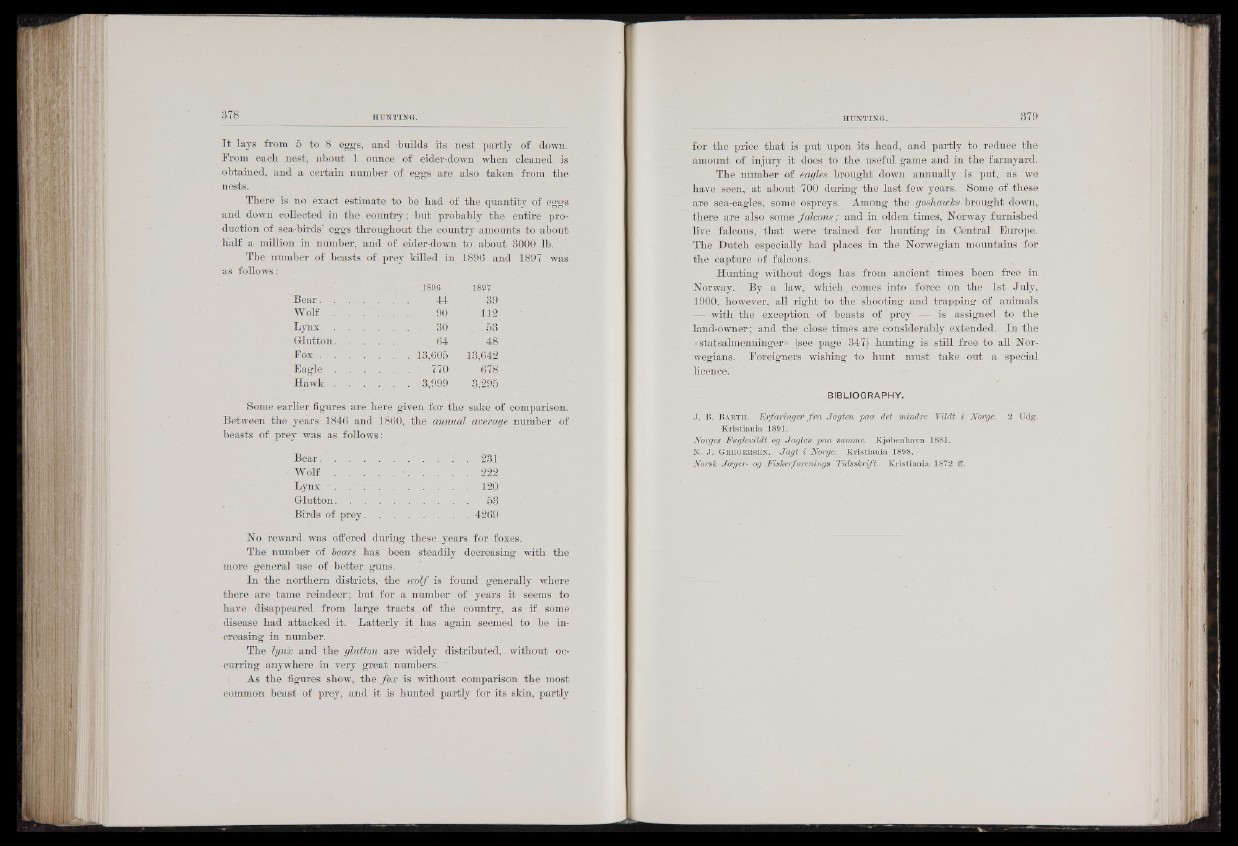
I t lays from 5 to 8 eggs, and -builds its nest partly of down.
From each, nest, about 1 ounce of eider-down wben cleaned is
obtained, and a certain number of eggs are also taken from the
nests.
There is no exact estimate to be had of the quantity of eggs
and down collected in the country; but probably the entire production
of sea-birds’ eggs throughout the country amounts to about
half a million in number, and of .eider-down to about 3000 lb.
The number of beasts of prey killed in 1896 and 1897 was
as follows:
1896 1897
Bear. . . . 44 39
Wolf . . . . . . 90 112
............... . . . 30 , .. 53
Glutton. . 64 . 48
Fox . . . . . . .. 13,605 13,642
Eagle . . . . 770 678
Hawk . . .. , . . . 3,999 3,295
Some earlier figures are here given for the sake of comparison.
Between the years 1846 and 1860, the annual average number of
beasts of prey was as follows:
B e a r . ........................... . . i . 231
Wolf . . . . . - . ... . . . 222
Lynx - . . . . . . . . . . 120
Glutton. . . . , ....................... 53
Birds of prey. . . . . . . . 4269
No reward was offered during these years for foxes.
The number of bears has been steadily decreasing with the
more general use of better guns.
In the northern districts, the wolf is found generally where
there are tame reindeer; but for a number of years it seems to
have disappeared from, large tracts of the country, as if some
disease had attacked it. Latterly it has again seemed to be increasing
in number.
The lynx and the glutton are widely distributed, without occurring
anywhere in very great numbers. "
As the figures show, the fox is without comparison the most
common beast of prey, and it is hunted partly for its skin, partly
for the price that is put upon its head, and partly to reduce the-
amount of injury it does to the useful game and in the farmyard.
The number of eagles brought down annually is put, as we
have seen, at about 700 during the last few years. Some of these
are sea-eagles, some ospreys. Among the goshawlcs brought down,
there are also some falcons; and in olden times, Norway furnished
live falcons, that were trained for hunting in Central Europe.
The Dutch especially had places in the Norwegian mountains for
the capture of falcons.
Hunting without dogs has from ancient times been free in
NorwayT By a law, which .comes, into force on the 1st July,
1900, however, all right to the shooting and trapping of animals
— with the exception of beasts of prey - , is assigned to the
land-owner; and thesfjose times are considerably extended. In the
«statsalmenninger» (see page 347) hunting is still free to all Norwegians.
Foreigners wishing to hunt must take out a special
licence.'
BIBLIOGRAPHY.
J . B. Ba b t h . • Ei-faringer f r a Jagten paa del mindre Vildt i Nor.ge. 2 Uclg.
Kristiania 1891;
Norges Fuglevildt og Jagten paa samme. Kjabenhavn 1881.
N. J. Gb eg e p .s e n . Jagt i Norge. Kristiania 1898. ■
Norsk Jceger- og Eiskerforenings Tidsskrift. Kristiania 1872 ff.